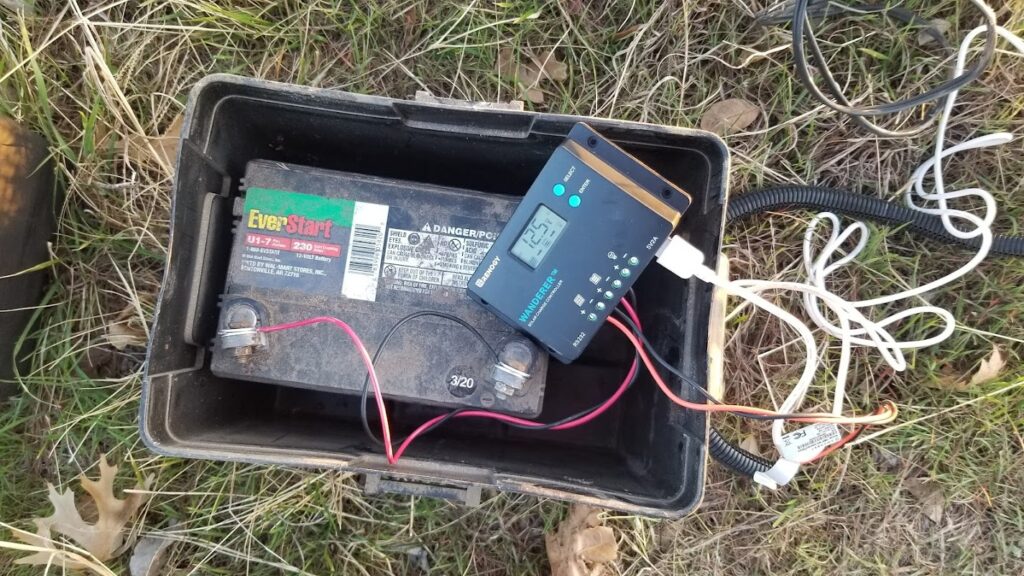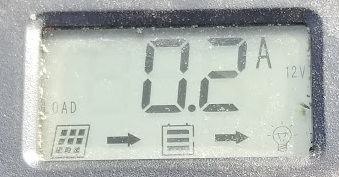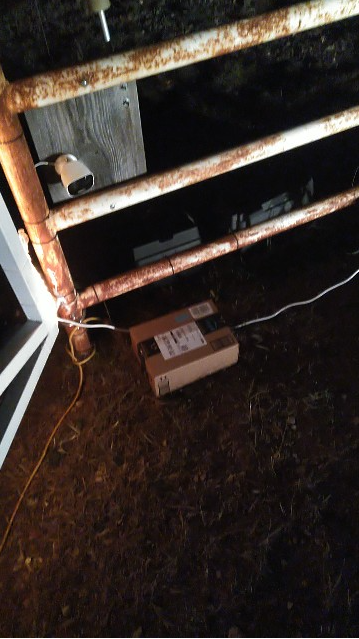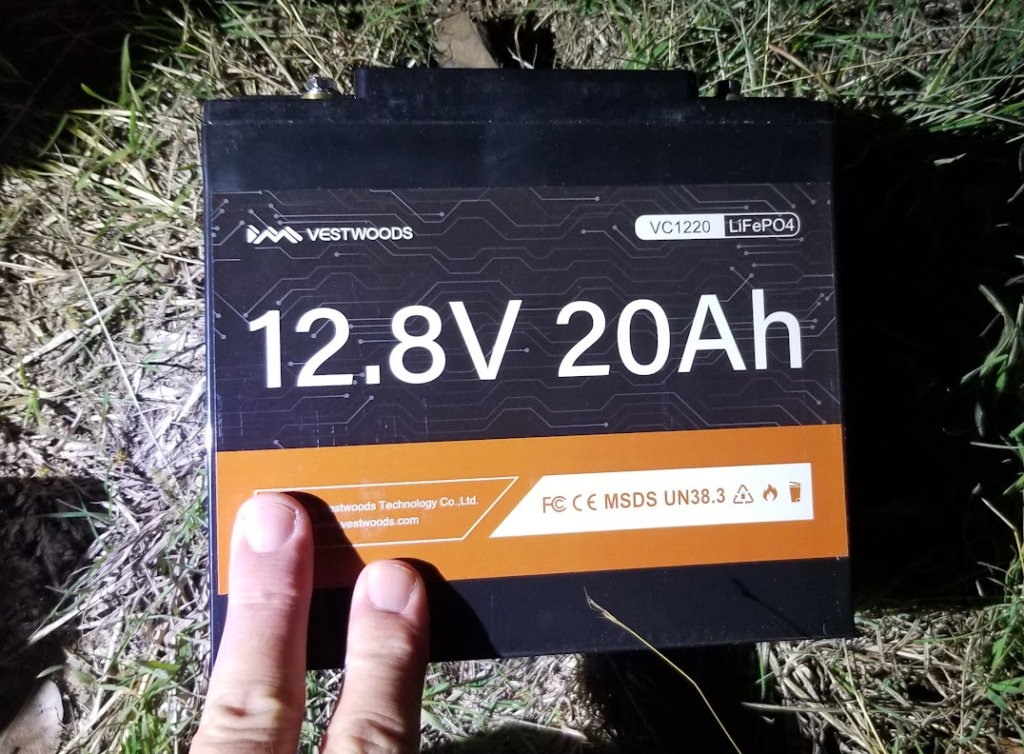I have mentioned that I have a camera mounted by our front gate, powered by a dedicated solar panel, charger and battery.
I chose this Renogy Wanderer 10A solar charge controller specifically because it has USB power outlets built in, elegantly feeding the USB power cord to the camera.
The battery box lid, designed for indoor use apparently, had air vents on the top and allowed rain inside. The first controller died a wet death. I covered those air vents. It’s not as if the rest of the lid fits with a hermetic seal, so the box is still well ventilated, but now it is at least rain tight.
Wintertime is tough on solar stuff. So many overcast days result in less efficient charging. The camera draws 100-200mA;. The granularity of the charge controller’s output meter is 0.1A and it’s usually says 0.1A, but sometimes it’s 0.2A. Maybe when it is darker and the IR illuminator is on?
A couple of overcast days is enough for the lawn tractor battery to fall behind and drop power, especially after dark. The tractor battery is not intended for deep cycle use, although the gate controller is only on it’s 2nd battery in about 10 years. I think the constant drain of the camera, even at only 200mA, is probably the issue.
I have considered changing the battery to an actual deep cycle battery. WalMart carries an inexpensive ($80-ish) marine battery in the 24 size class. Real specifications for that specific battery were elusive, but I found several 24 size marine batteries from other sources. If they mentioned it at all, the amp-hour rating was 75-80 AH, so that seems likely for the EverStart at WalMart.
A more useful number for power service is the watt hour, literally how many watts for how long. It’s really handiest when comparing power systems that might not be running the same voltage. Conversion of AH to WH is easy enough. Voltage times amperage is wattage. For example, an off-grid solar system running 12V with 100AH of battery can be compared directly to a 48V system with 25AH of battery because they would both provide 1200 watt hours of power.
12V x 100AH == 48V x 25AH
In the case of the EverStart, 80AH x 12V = 960WH. A 12 volt battery is rarely actually 12 volts. Lead-acid batteries like to charge at 2.25 or so volts per cell, so a 12V battery’s ideal charging voltage is 13.8V. The open circuit voltage for a fully charged battery is about 2.1 volts per cell, so 12.6 is typical. Plug that number into the formula and a 12.6 volt 80AH battery should be good for 1008 watt hours.
Once you have a watt hour rating, figuring out how long a charged battery should last is pretty straight forward. In the above example, under ideal conditions, you should be able to draw one watt for 1008 hours, 2 watts for 504 hours, 50 watts for 20+ hours, and so on.
In practice, lead acid batteries can be permanently damaged if discharged too deeply. Deep cycle batteries are optimized to limit this damage, but you can’t eliminate it. It’s just how the chemsitry in there works. It is good practice to limit discharging a lead acid battery to no more than 50% charge, so derating that watt hour rating by half would be wise. One watt for 504 hours, 2 watts for 252 hours, etc.
Assuming 200mA for the camera and the specified 10mA for the charge controller itself, an 80AH battery should be able to run the camera for 192 hours to the 50% charge level, or about 8 days. That shoudl be plenty.
Then again, lead acid batteries need maintenance, especially during the summer months. All the cool kids are using lithium iron phosphate batteries in their solar systems, mostly because they enjoy certain efficiencies, but also because they are essentially zero maintenance, so I started looking into that.
LiFePO4 batteries can be charged and discharged faster than lead acid, are much lighter and because of smart onboard electronics, don’t really need a super smart charger. They are not particular cheap, however.
I found that 20AH LiFePO4 batteries run similar in price to 80AH lead acid batteries. 20AH works out to 96 hours and these batteries protect themselves at about 75% discharge, so 72 hours is likely.
So, roughly the same price as the big lead acid batter and only 3 days without a charge, but zero maintenance and an arguably longer service life. I decided it was worth trying one out at the very least.
Via Amazon, I chose at Vestwoods 20AH battery. The Renogy charge controller has a lithium mode. Part of setting that mode involves setting the charge voltage. The labelling on the battery indicates that it is a 12.8 volt battery, so I took that as the best guess.
It was delivered at 7:24 on December 30, ironically about a foot from where it would be installed. Here’s Amazon’s delivery photo. The battery box nearest to it is where it goes and the camera above it is what it powers.
It’s about the size of a large motorcycle battery.
I connected it almost immediately, by flashlight.
According to the recordings from that camera, it ran from 9:05PM on December 30 until 12:37 AM New Years Day.
The immediate presumption was that changing the battery type caused an issue. I didn’t have a lot of free time to troubleshoot, so it took me a few days to determine that what had actually happened was that the power output from the charge controller had failed. All indications are that it is on, but there is no power on either the USB jacks or the screw terminals.
Before I found the Renogy charge controller, I had purchased a 12V to USB adapter, assuming I would be using something like that connected directly to a battery. Using that, I was able to at least get the camera operational again, pending the arrival of a replacement charge controller.



